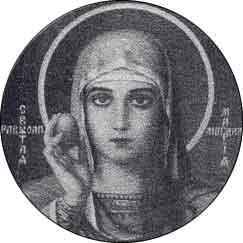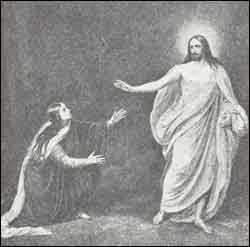 |
 |
|
 |
 |
|
|
On August 4th (July 22nd, old style) the Church commemorates the holy myrrh-bearer Mary Magdalene, equal-to-the-apostles.
Saint Mary Magdalene, who became best known in the Church for her ardent and selfless love for the Lord Jesus Christ, came from the wealthy city of Magdala, which was situated in Galilee, on the lake of Gennesaret, between the cities of Capernaum and Tiberias.
|
|
Because of her provenance from Magdala, St. Mary has been named the Magdalene, in order to distinguish her from the other righteous women mentioned in the Gospel under the name of Mary.
St. Mary Magdalene was a true Galilean. Galilee differed greatly from Judea, both in its physical nature and in the character of its inhabitants. In Galilee the physical nature was verdant and abundant, while the population was lively and simple; Judea was a barren desert and its people were unwilling to accept anything but the letter and form of the law.
|
 |
|
|
The inhabitants of Galilee willingly accepted the spirit of the law and its ideas; among the Jews of Jerusalem reigned solely external routine. Galilee became the cradle of Christianity: all the apostles, with the exception of Judas the betrayer, were Galileans; the majority of Christ’s followers were from Galilee; even the Lord Himself grew up in Galilee from infancy and later preached there extensively. Judea, on the other hand, was withered by impious Pharisaism and Sadduceeism. Galileans were ardent, warm-hearted, impulsive, grateful, honest, courageous, sincere and hard-working; they were fervently religious and loved to listen to teachings about faith and God. Even the Jewish Talmud testifies to the fact that the Galileans cared primarily about glory, while the Jews cared primarily about money; but the Galileans did not establish any centers of learning, and because of this the haughty scribes and Pharisees looked upon them as fools and illiterates. Mary Magdalene, who was healed by Jesus Christ, exemplified in her life many of the wonderful characteristics of the Galileans, who were the first and most zealous Christians.
The only thing that is known about Mary Magdalene’s early life is that she suffered from a terrible incurable illness, was possessed, according to the Gospel, “by seven demons.” The cause and circumstances of this misfortune are unknown, but the holy Gospel and the Church Fathers teach us that such particularly heavy suffering is allowed by God’s Providence in order to “reveal the works of God,” i.e. for the glory of God and the Lord Jesus Christ, and for the spiritual enlightenment and salvation of Mary Magdalene herself. If she hadn’t suffered so terribly and incurably, she could have remained far from Christ, or she could have responded to His miracles with curiosity and amazement, but without living faith, and in that case she would not have become uplifted to such a degree of love for the Lord, that she was rewarded by seeing the resurrected Christ even before His closest disciples. But Mary Magdalene, hearing of the great Wonder-worker Who was passing though her native Galilee, hastened to Him to be healed, and in accordance with her faith received what she asked for: the tormenting force of the evil spirits left her and, as an ardent and grateful Galilean, she dedicated herself to serving Jesus Christ. From that time she followed Him everywhere, listened to His divine teaching and, together with other righteous women, served Him with her estate.
For her faithfulness and great love for Christ, Mary Magdalene had the honor of accompanying Him to Golgotha, of succouring Him during His suffering on the cross, of being present when His body was taken down from the cross, transferred to Gethsemane and buried in the sepulcher. And this same fervent love for Christ encouraged Mary Magdalene to become a myrrh-bearer, having talked the other women into going together with her early in the morning to the sepulcher, carrying aromatic essences and myrrh to anoint the body of Christ. But as they approached the sepulcher, the myrrh-bearers remembered that the entrance was sealed with a huge stone which they would be unable to roll away. And then they started talking among themselves: “Who shall roll away the stone from the door of the sepulcher for us?”
While pondering this thought, Mary Magdalene overtook the other myrrh-bearers and came first to the sepulcher, where she saw, to her great amazement, that the stone was already rolled away. Then she became worried that Christ’s body may have been transferred to another place, and she hurriedly ran back to Jerusalem, in order to let the apostles know what was happening at the Lord’s sepulcher. “They have taken away the Lord from the sepulcher and we know not where they have laid him,” - she said to the apostles. Hearing this, the apostles Peter and John immediately went to the sepulcher. Peter entered first and went out wondering, while John, seeing the carefully folded winding sheets and the head covering lying separately, silently came to believe that Christ was risen.
When the disciples left, Mary Magdalene once more returned to the sepulcher and leaned in, all in tears. And suddenly she saw there two angels in white raiment, who asked her: “Woman, why are you weeping?” Mary answered: “They have taken away my Lord and I know not where they have laid Him!” Mary’s grief was so overwhelming that she did not realize she was speaking not to people, but to angels, and so she told them the same thing she had told the apostles.
|

St. Mary is the first to see Resurrected Christ. |
Meanwhile, Christ Himself appeared behind Mary, but by God’s will she did not immediately recognize Him, but took Him to be the gardener. Christ compassionately asked her: “Woman, why are you weeping? Whom are you seeking?” Mary trustingly answered: “Sir, if you have borne Him away, tell me where you have laid Him and I will take Him.” Then the Lord, moved by the ardent force of Mary’s love, in a familiar voice called her name: “Mary!” Hearing this wondrous voice with which He had expelled a legion of demons from her, Mary turned towards the Lord, recognized Him with enlightened eyes and rapturously crying out just one word: - “Master!” - threw herself at Christ’s feet…
|
|
|
After that, following the Lord’s command, Mary Magdalene goes and informs Christ’s disciples about His appearance to her, and comforts their sorrow with the wondrous words: “Christ is risen!” For this reason, being the first messenger of Christ’s resurrection, and having been sent by Christ Himself, Mary Magdalene is called by the Church - “Equal-to-the-apostles.” Therein lies the key to Mary Magdalene’s wonderful service. On the morning of Christ’s Resurrection, of all Christ’s disciples and followers, she was the first (after the Mother of God) to see the risen Christ and the first to become the messenger of His resurrection. The apostles preached Christ’s Resurrection to the entire world, while Mary Magdalene preached Christ’s Resurrection to the apostles themselves: thus she became in a way an apostle to the apostles! Afterwards, together with the other myrrh-bearing women, she went from house to house, from one group of Christ’s disciples to another, and to all of them she brought the same joyous message:
- “Christ is risen! Truly He is risen!”
And from this small seed - the devoted handful of Christ’s disciples and followers - grew the great tree of the Church of Christ, and throughout the entire world were announced the triumphant words of Mary Magdalene’s first message: “Christ is risen! Truly He is risen!”
The holy myrrh-bearer Mary Magdalene at first stayed with the Holy Virgin and the apostles, helping them to spread the Christian faith in Jerusalem, but later she traveled to other countries, carrying her joyous message everywhere. Once, when she visited Italy during her travels, Mary Magdalene found the opportunity to appear before the then-reigning Emperor Tiberias, and presented him with a red-colored egg, saying: “Christ is risen!” Emperor Tiberias was not surprised by the humbleness of Mary’s gift, because he was acquainted with the ancient Eastern custom of poor people honoring others with gifts of fruit from their regions or the eggs of fowl, but he was amazed at the unexpected greeting. Having aroused the Emperor’s curiosity, Mary Magdalene began her fervent preaching of the Resurrection and the teaching of Christ. According to tradition, Tiberias came to believe in Christ and issued a proclamation which threatened punishment to anyone who gave offense to Christians.
The Christians of those times, having learned of the impression that the gift of the red-colored egg, together with the words “Christ is risen!” had made on Tiberias, began to follow Mary Magdalene’s example, and honored Christ’s Resurrection by exchanging red-colored eggs and saying: “Christ is risen!… Truly He is risen!”
Little by little this custom spread everywhere and became common to Christians all over the world, while the egg became a symbol of the Resurrection of Christ and the general resurrection of the dead, and of our rebirth into eternal life.
|
 |
|
|
|
|
 |